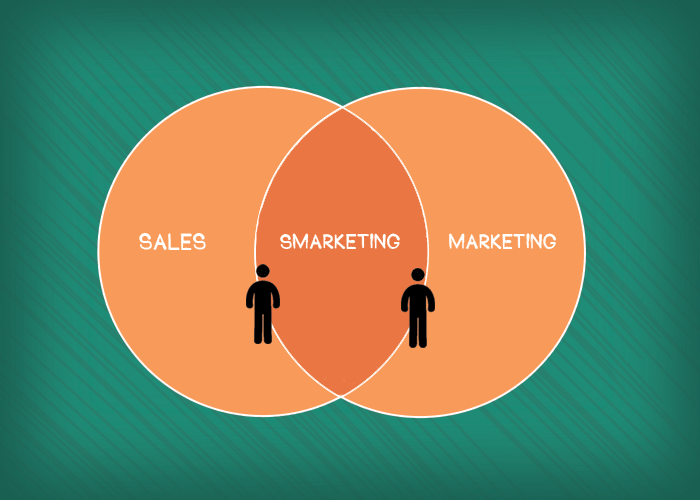If you’re in a sales or marketing profession, you’ve probably heard the word “smarketing” more than a few times this past year. It’s gimmicky, for sure, but is there a deeper meaning? Is smarketing something your business should embrace?
Some have suggested that marketing is really just sales drawn out over a longer period of time, and sales is just marketing condensed into a shorter period of time. At a cursory glance, smarketing seems to echo this idea, suggesting the fusion of two departments into one new department.
But that’s not the case. Marketing and sales will always be tactically distinct and have different responsibilities. Smarketing supports this framework, but adds a singularity of purpose to it, using the common goals of both departments to drive bottom line growth.
What is Smarketing?
Simply put, smarketing is sales and marketing alignment; it’s an initiative to bring both teams together through open communication, bi-directional data flow, and a shared set of deliverables. Smarketing treats the buyer journey as one continuous process which sales and marketing manage at different points.
The most basic manifestation of smarketing is consistent language — agreeing on definitions for terms such as “lead,” “prospect,” “opportunity,” and “qualified,” as well as deciding where different stages of the buyer journey begin and end. Fully evolved, smarketing may entail formal structures for data exchange (marketing automation and CRM integration) and performance goals around shared metrics. Some companies even draw up a service level agreement (SLA) to hold each department accountable.
Despite all the buzz about smarketing, most businesses still underperform. In a recent survey, SiriusDecisions found that 58 percent of companies have “poor” operational alignment between sales and marketing. They outline four key areas for improvement:
- Planning: Collaborate on revenue goals, budgets, go-to-market plans, resources, and investments.
- Lead management: Agree on a system for capturing, nurturing, qualifying, and converting leads, and allocate specific responsibilities to each team.
- Data management: Ensure lead data is accurate and accessible to both teams through their respective information systems.
- Measurement: Decide which metrics to track, which data sources will feed strategic analysis, and how often to run reports.
Why Smarketing is Valuable
As a byword, smarketing doesn’t mean much outside of the break room. But as a business strategy, it offers some distinct advantages. Here are four things you’re missing out on if you aren’t smarketing:
1) More qualified leads
According to MarketingSherpa, 73 percent of all B2B leads are not sales-ready. If your sales and marketing teams get on the same page about lead scoring and qualification, you’ll likely see a rise in the percentage of qualified leads delivered (even if the overall volume decreases). That’s because marketers know what content to create and how to promote it in a way that helps sales reps start rewarding conversations. Better qualified leads = higher conversion rates = more revenue.
2) A shorter sales cycle
B2B companies that practice “smarketing” (wittingly or unwittingly) have 24 percent faster revenue growth, on average. This rapid growth can be attributed, in part, to a shorter sales cycle. When sales can draw from a pool of qualified leads and obtain insight about those leads (channel source, first click, firmographics, browsing behavior, etc.) before they reach out, it takes less time and effort to get a final handshake.
3) Wise spending
In a smarketing model, marketing is subservient to sales. Their content, campaigns, and channel strategies are all aligned with — even accountable to — the needs of the sales team. Brand awareness, retention, and loyalty are still important parts of the marketing paradigm, but the main goal is to bring financial return. This shift in priorities forces marketers to trace campaign spend to specific business outcomes and trim fat where necessary.
4) No more silos
Unlike the traditional configuration where marketing and sales only collaborate amongst themselves, smarketing creates a single communication loop for both departments. This happens first on a strategic level, by including sales stakeholders in marketing meetings, emails, and shared documents (and vice versa), especially when prospects, leads, or revenue goals are being discussed. Then it happens on a technical level, through integrated systems (CRM and lead generation software) that exchange data in real time. In this open environment, the separation between marketing intelligence and sales intelligence will quickly dissolve.
***
“Smarketing” may only be a word, but the principles behind it have profound implications for the future of business strategy, especially where demand generation is concerned. Companies that “smarket” will produce higher quality leads and exert less time and energy trying to convert them, which ultimately leads to more profit.

